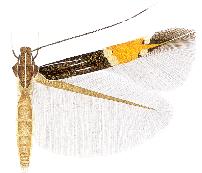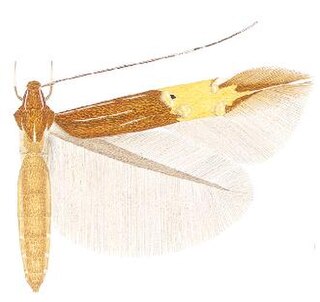Adult
Male, female. Forewing length 3.0-4.0 mm. Head: frons shining grey, shining white towards clypeus, vertex and neck tufts shining dark brown, laterally and medially lined white, collar shining dark brown; labial palpus first segment very short, white, second segment four-fifths of the length of third, shining white on inside, dark brown with a white longitudinal line on outside, third segment white, lined brown laterally; scape dorsally shining dark brown with a white anterior line, ventrally shining white, antenna shining dark brown with a white interrupted line from base to beyond one-half, near base often uninterrupted, followed towards apex by five dark brown segments, one white, one dark brown, one white, three dark brown, one white, approximately twelve dark brown, three white and five dark brown segments at apex. Thorax and tegulae shining dark brown, thorax with a white median line. Legs: shining dark brown, foreleg with a white line on tibia and tarsal segment one, tibia of midleg with white oblique basal and medial lines and a white apical ring, tarsal segments one and two with white apical rings, segment five entirely white, tibia of hindleg as midleg, tarsal segments four and five entirely white, spurs white dorsally, brown ventrally. Forewing shining dark brown, three short silver streaks in the basal area, sometimes with a pale golden gloss, a subcostal nearest to base and bending from costa distally, a shorter medial underneath the distal end of the subcostal, a subdorsal, as long as the subcostal but further from base, a bright orange transverse fascia beyond the middle, narrowing towards dorsum, in some of the specimens from the USA the fascia is partly or completely darkened, bordered at the inner edge by broad tubercular pale golden metallic fascia, sometimes with a pinkish gloss, perpendicular at dorsum, edged blackish on the outside, bordered at the outer edge by a similarly coloured inwardly oblique fascia, edged blackish on the inside, at the costa of the outer fascia a broad white costal streak, the apical line as a silver metallic spot with bluish reflection in the middle of the apical area and a broad white spot in the cilia at apex, cilia dark brown. Hindwing shining brown, cilia brown. Underside: forewing shining dark greyish brown, the white costal streak and apical spot distinctly visible, hindwing shining dark greyish brown. Abdomen shining dark brown dorsally, ventrally segments banded white posteriorly, anal tuft brown. [1]

